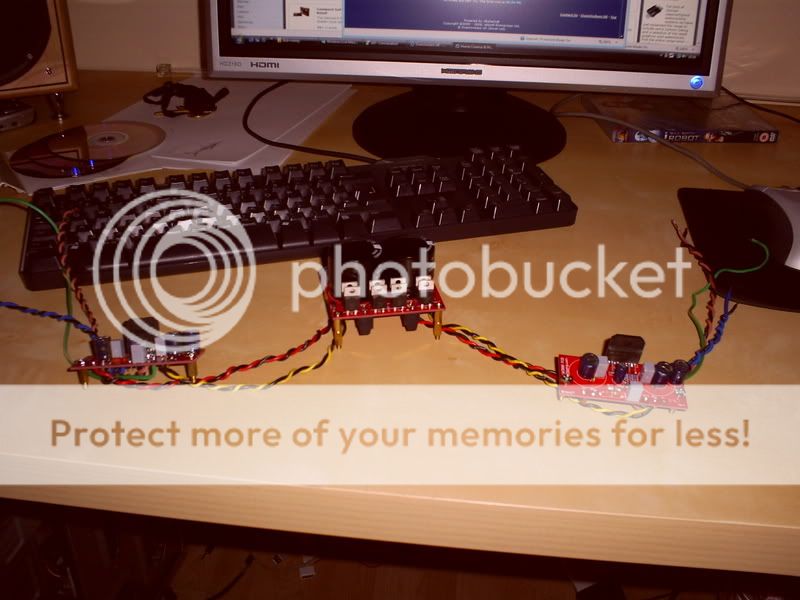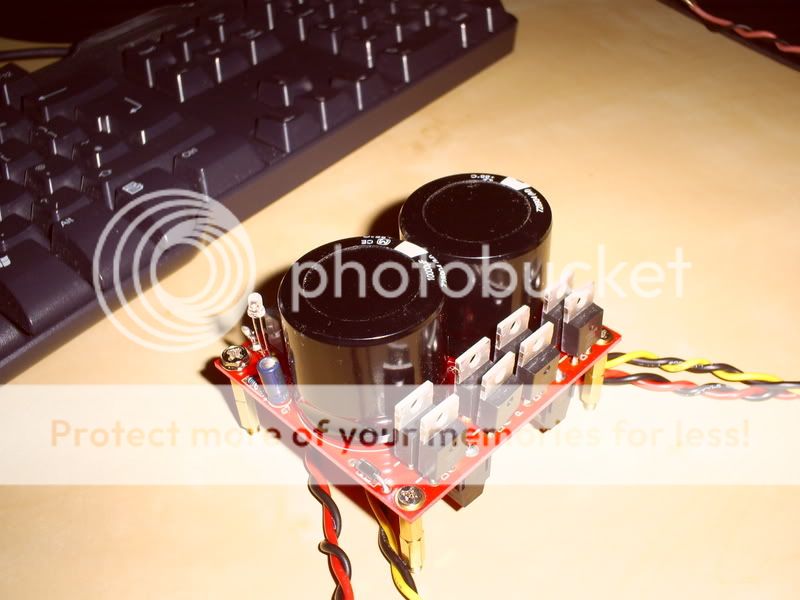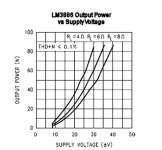Hi all, just finished construction of my chipamp.com amp and im looking for a suitable transformer for it, i found these but just looking for some clarification which would be better for me?
Primary 230Vac
Secondary: 2 x 18v @ 6.25A
Regulation: 7%
or
Primary 230Vac
Secondary: 2 x 25v @ 4.50A
Regulation: 7%
or this
Primary 230Vac
Secondary: 2 x 35v @ 3.21A
Regulation: 7%
And if im just well off the mark and none of these are suitable what should i be looking for?
heres some snaps as i cant help my self




Primary 230Vac
Secondary: 2 x 18v @ 6.25A
Regulation: 7%
or
Primary 230Vac
Secondary: 2 x 25v @ 4.50A
Regulation: 7%
or this
Primary 230Vac
Secondary: 2 x 35v @ 3.21A
Regulation: 7%
And if im just well off the mark and none of these are suitable what should i be looking for?
heres some snaps as i cant help my self


An externally hosted image should be here but it was not working when we last tested it.


Looks nice so far!
You should be fine with either the 2*18V or 2* 25V options. They should rectify out to 25V and 35V respectively, which are within the recommendations for the chip. The 35V secondaries, on the other hand, would produce ~50V rails, which would be greater than what the chip was designed to take, so the third option is right out!
The amperage ratings for both of the first two seem sufficient, so I wouldn't worry about either. The potential concern would be that the +/- 35V rails would cause the chip to produce more heat than the +/-25V rails, so make sure your heat sink is adequate if you use the larger rail voltages.
You should be fine with either the 2*18V or 2* 25V options. They should rectify out to 25V and 35V respectively, which are within the recommendations for the chip. The 35V secondaries, on the other hand, would produce ~50V rails, which would be greater than what the chip was designed to take, so the third option is right out!
The amperage ratings for both of the first two seem sufficient, so I wouldn't worry about either. The potential concern would be that the +/- 35V rails would cause the chip to produce more heat than the +/-25V rails, so make sure your heat sink is adequate if you use the larger rail voltages.
The attached chart might explain it.
EDIT: Multiply the individual AC rails voltage by 1.45 to get an approximate DC voltage (rectification to DC makes that difference).
EDIT2: For example, the 25+25vac transformer makes approximately 36vdc rails, which, according to the chart, is a centerpoint tolerance for "most" speakers.
EDIT: Multiply the individual AC rails voltage by 1.45 to get an approximate DC voltage (rectification to DC makes that difference).
EDIT2: For example, the 25+25vac transformer makes approximately 36vdc rails, which, according to the chart, is a centerpoint tolerance for "most" speakers.
Attachments
Not surprising since they would have the same amount of copper in each.kanifee said:. . . the price of the 2 are identical so not really a concern.
You will get marginal power gains with the higher rail voltages, and has been mentioned, if you know you will be driving 8ohm loads exclusively, there is no reason not to go with the larger of the two except for heat. Having the larger rails will result in more heat at the same music power, so be sure to double check that you can dissipate enough heat to adequately use the +/-35V rails if you do go that route.
This might simplify it. With 8 ohm speakers, the 2x 18vac transformer option would give you a 25 watt amplifier.
However, the 2 x 25vac transformer option will run your amplifier at near its expected power output, albeit needing larger heatsinks.
Something like 2x 22vac transformer might also be a good option.
Next up, what sort of preamp have you selected to match up with your power amp kit?
However, the 2 x 25vac transformer option will run your amplifier at near its expected power output, albeit needing larger heatsinks.
Something like 2x 22vac transformer might also be a good option.
Next up, what sort of preamp have you selected to match up with your power amp kit?
I was planning on using my pc as the preamp for now, i do hope to build a preamp in the very near future with the active crossovers built into the power amp later on.
I have been told that this is the way to get the best from your setup, power amp, preamp and activ x-overs and run the speakers streight from the amp without there passive ones.
Id like to build the preamp from a kit or if im feeling a little braver from scratch maybe point to pont?
have you gto any good suggestions, oh and my speakers have 6 ohm tweeters and 8 ohm mid drivers, im not to fussed about bigger sinks ill sort them out not a problem, so id proberbly like to go with t he larger of the two transformers!
I have been told that this is the way to get the best from your setup, power amp, preamp and activ x-overs and run the speakers streight from the amp without there passive ones.
Id like to build the preamp from a kit or if im feeling a little braver from scratch maybe point to pont?
have you gto any good suggestions, oh and my speakers have 6 ohm tweeters and 8 ohm mid drivers, im not to fussed about bigger sinks ill sort them out not a problem, so id proberbly like to go with t he larger of the two transformers!
kanifee said:I was planning on using my pc as the preamp for now, i do hope to build a preamp in the very near future with the active crossovers built into the power amp later on.
Id like to build the preamp from a kit or if im feeling a little braver from scratch maybe point to pont?
Have you any good suggestions. . .
A USB DAC with preamp!
That suggestion is because even the expensive computer sound cards may have crummy op amps aboard. It makes good sense to build your own so you can choose quality output from your computer.
There's also TDA1524A chip, which is a voltage-based bass-n-treble control + preamp unit. It doesn't run your signal through the control pots or against an RC, as it is higher-class voltage based preamp, like a RIIA amp. Anyway, its clearer than a software eq.
Its my own personal definition of transparency, that it is clarity without distraction.
This is the cause of my recommendation of a USB DAC (clarity) and a frequency response set in favor of the ear (without distraction).
I can't help on the active crossover idea because I haven't, personally, used a large enough sample of them for comparison (no baseline). See the loudspeaker forum for a good "head start" on that topic.
TDA1524A chip <--- so this would take care of my bass and treble control in my preamp and then i would need a stereo pot for volume control in the pre amp or something else? i am a little noobish still so mind my lack of knowladge on pre amps, i only really just found out they even existed when i started this project never mind what they were for.
And then a usb dac to take care of the audio instead of the sound card or in conjuction with? never used a usb dac before!
And then a usb dac to take care of the audio instead of the sound card or in conjuction with? never used a usb dac before!
Kanifee.
If you want to read up on why chipamps may need a buffer or preamp try (as always) Decibel Dungeon.
http://myweb.tiscali.co.uk/nuukspot/decdun/gainclonepre.html
I'm using the "Uno" active pre with my LM3875. It can be done on stripboard but has no tone controls, I'm more than happy with it.
Have a browse through the site as there's a wealth of info on there.
Good luck
John
If you want to read up on why chipamps may need a buffer or preamp try (as always) Decibel Dungeon.
http://myweb.tiscali.co.uk/nuukspot/decdun/gainclonepre.html
I'm using the "Uno" active pre with my LM3875. It can be done on stripboard but has no tone controls, I'm more than happy with it.
Have a browse through the site as there's a wealth of info on there.
Good luck
John
The USB DAC is instead of the sound card.
D.A.C. = Digital to Analog Converter.
It solves the problem in getting your music out of your PC intact, so a USB DAC doesn't utilize a sound card within the audio chain (thereby making a USB DAC useful).
A reliable source is www.audiosector.com (scroll down the page until you reach the "latest news" section, with mention of the USB DAC).
See http://www.diyaudio.com/forums/showthread.php?postid=603983#post603983 for more information.
D.A.C. = Digital to Analog Converter.
It solves the problem in getting your music out of your PC intact, so a USB DAC doesn't utilize a sound card within the audio chain (thereby making a USB DAC useful).
A reliable source is www.audiosector.com (scroll down the page until you reach the "latest news" section, with mention of the USB DAC).
See http://www.diyaudio.com/forums/showthread.php?postid=603983#post603983 for more information.
Not to ruin the party, or to suggest that you shouldn't build a preamp if you want, but I am running a LM3886 dual monoblock amp straight out of my soundcard at my office, and it sounds fantastic. I have decent on-board sound card on my computer, and the limit of the system is definitely my speakers. Unless you already have a super spiffy pair of speakers, I would save the $$$ you would plunk down on a preamp and save for new drivers.john blackburn said:If you want to read up on why chipamps may need a buffer or preamp try (as always) Decibel Dungeon.
I know you are wanting to run an actively crossed over system, and I would highly recommend waiting until you decide on what type of crossovers you want to use before you start mucking around with preamps. Reason being, you will want to make sure that your preamp is capable of driving the potential multitude of inputs you may or may not decide to use with your active xover when the time comes. I, personally, would put a buffer in front of each active xover channel when building the xovers, obviating the "need" for a preamp.
Just food for thought. There certainly are a multitude of chipamp based systems running straight off of the soundcard line outs of computers, so PLEASE, don't think a preamp is a necessity.
Its a very large and confusing world the land of DIY audio lol!
Im not to sure what direction im wanting to take this project in, im a bit of a tart when it comes to things though so my initial thoughts were high end audio setup, nice bulky solid power-amp with active xovers with a high end audio look, matching pre amp with bass, treble, input selection and volume controls with some sort of DIY dac for at minimum digital coax.
Im even putting thought to stripping out a ps1 and putting it in a matching case for a cd unit but id like a display really so i think that would be out of the question unless i go uber diy high end and fit an lcd screen for on screen music selection, so next would be a retail cd player gutted and fitted to a matching case, that is of course me just getting ahead fo my self.
I see your point on maybe putting a little aside for better speakers, my eltax monitors arnt the greatest so a pair of speakers would have a great impact on the overall quality of the rig. Im allready looking into "High-performance" mods i can make to the stock lm3886 but this will all be after testing etc;
Im trying to take onboard everything im wreading but its like info overload!
Im not to sure what direction im wanting to take this project in, im a bit of a tart when it comes to things though so my initial thoughts were high end audio setup, nice bulky solid power-amp with active xovers with a high end audio look, matching pre amp with bass, treble, input selection and volume controls with some sort of DIY dac for at minimum digital coax.
Im even putting thought to stripping out a ps1 and putting it in a matching case for a cd unit but id like a display really so i think that would be out of the question unless i go uber diy high end and fit an lcd screen for on screen music selection, so next would be a retail cd player gutted and fitted to a matching case, that is of course me just getting ahead fo my self.
I see your point on maybe putting a little aside for better speakers, my eltax monitors arnt the greatest so a pair of speakers would have a great impact on the overall quality of the rig. Im allready looking into "High-performance" mods i can make to the stock lm3886 but this will all be after testing etc;
Im trying to take onboard everything im wreading but its like info overload!
kanifee said:Its a very large and confusing world the land of DIY audio lol!
Im not to sure what direction im wanting to take this project in, im a bit of a tart when it comes to things though so my initial thoughts were high end audio setup. . .
Well, you might take a little break to research active crossovers. This implies (to me) that there is one power amp module per each driver. It doesn't seem like you're headed in that particular direction at this time.
On the current project:
I wasn't aware that you are going high end. So, here's, a bit of consideration to dynamics. For example, on a stereo layout (one transformer), when a demand is made by the left channel, the power also drops for the right channel. However, a dual mono setup (two power supplies, two transformers) doesn't do that, so the dual-mono is capable of more dynamics.
The issue is unimportant for quiet, relaxing, listening; however, its a necessary consideration if you enjoy exuberance.
No kidding!kanifee said:Its a very large and confusing world the land of DIY audio lol!
Remember, if you are on a limited budget, your highest impact item will ALWAYS be your drivers! Most chip-amps are quite capable of cleanly driving speakers at moderate levels, so don't get too caught up in trying to tweak your amp too much. Daniel will (and has) suggested every esoteric tweak imaginable, so taking him with a grain of salt is highly recommended.
If you are looking for a good primer on active crossed speakers, you would be well served to check out Siegfreid Linkwitz's website where he documents his highly regarded active speakers. He also throws in a recommendation for an LM3886 circuit that I rather like, and contrary to Daniel's instance, Linkwitz uses ONE power supply for all of the 8 amplifier chips in his active system--I would dare anyone to suggest that Linkwitz's designs aren't "high end" or "exuberant."
Just so that there is no misunderstanding here: dual power supplies are NOT necessary for a very good amplifier. There is, of course, an argument for dual mono-block amplifiers, but pragmatically, you must decide whether the very subtle reduction in
dfdye said:Just so that there is no misunderstanding here: dual power supplies are NOT necessary for a very good amplifier.
This is most certainly true.
And, here I thought I was "playing it safe" but, of course, any mention of options does have a problem of its own.
Perhaps I should have asked more throughly about the application.
Well, here's a start:
Are your tastes more towards classical or popular?
Do you like your music moderate or loud?
Do you store your music inside the computer to use its automated playlist features, or do you store your music on CD?
And, please add a short description of what is satisfying about your current speakers and what isn't, as there "may" or "may not" be a suitable, specific, accomodation available.
Lastly, please describe your favorite place to listen to music, other than the home, and describe what is most endearing about that music.
The answers will better define the application.
And, given a narrower scope, I'd make a lot more sense. . . possibly.
- Status
- This old topic is closed. If you want to reopen this topic, contact a moderator using the "Report Post" button.
- Home
- Amplifiers
- Chip Amps
- transformer for my chip amp?
